Entrepreneurship & Small Business Management: Venture Evaluation
VerifiedAdded on 2023/05/17
|28
|13198
|484
Report
AI Summary
This report provides a comprehensive analysis of entrepreneurship and small business management, examining different types of entrepreneurial ventures such as corporate, public, and social entrepreneurship, along with the rewards and risks associated with entrepreneurial activity. It investigates how entrepreneurial risks can be addressed and mitigated, explores the key traits of entrepreneurs, and assesses the impact of Small and Medium Enterprises (SMEs) on the economy. The report also discusses the importance of public and corporate intrapreneurship and social enterprises, providing real-life examples and critically examining the role of Corporate Social Responsibility (CSR) in the private sector. It further delves into the difficulties and challenges faced by young entrepreneurs and proposes a motivational strategy to enhance organizational performance. The document concludes by emphasizing the significance of innovation and strategic planning in entrepreneurial success.
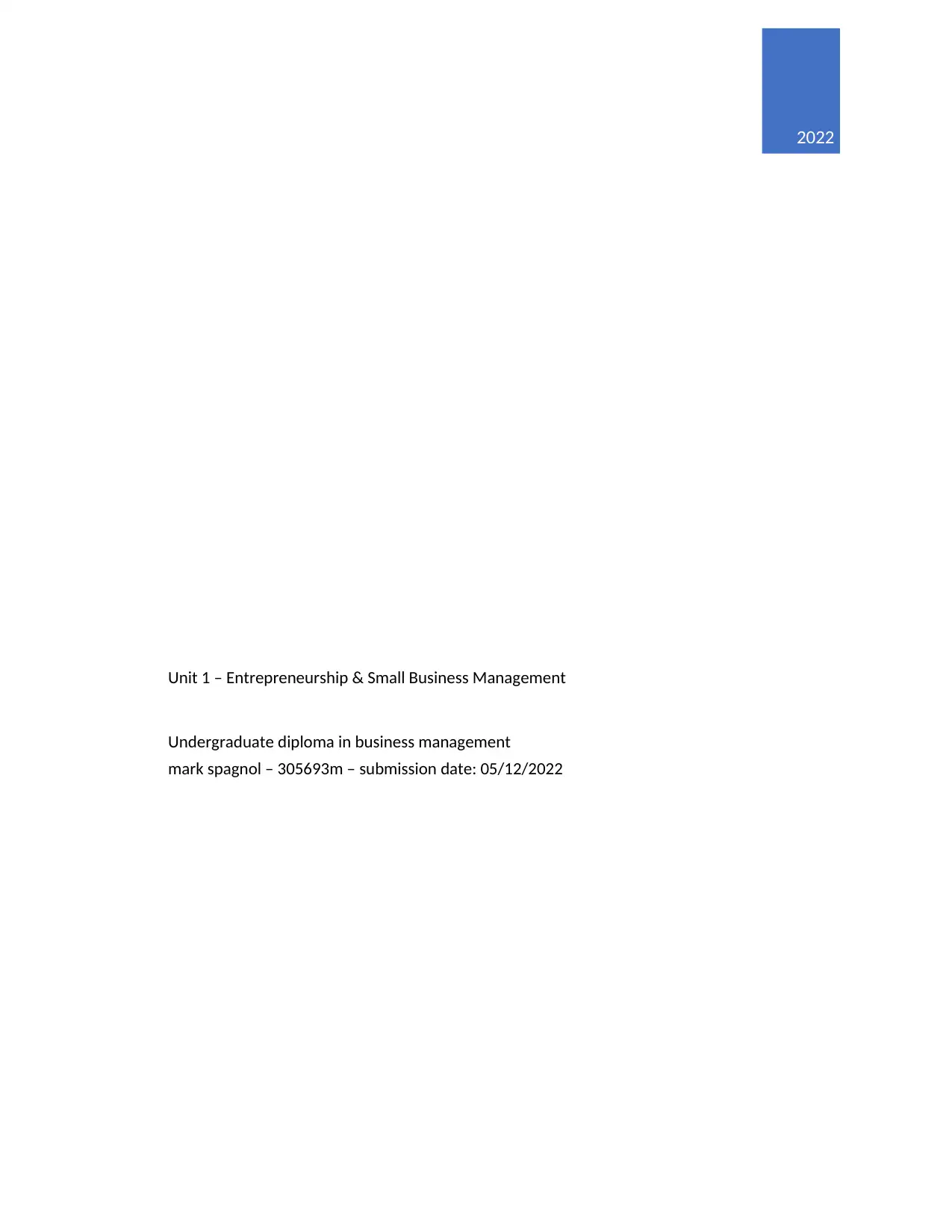
2022
Unit 1 – Entrepreneurship & Small Business Management
Undergraduate diploma in business management
mark spagnol – 305693m – submission date: 05/12/2022
Unit 1 – Entrepreneurship & Small Business Management
Undergraduate diploma in business management
mark spagnol – 305693m – submission date: 05/12/2022
Paraphrase This Document
Need a fresh take? Get an instant paraphrase of this document with our AI Paraphraser
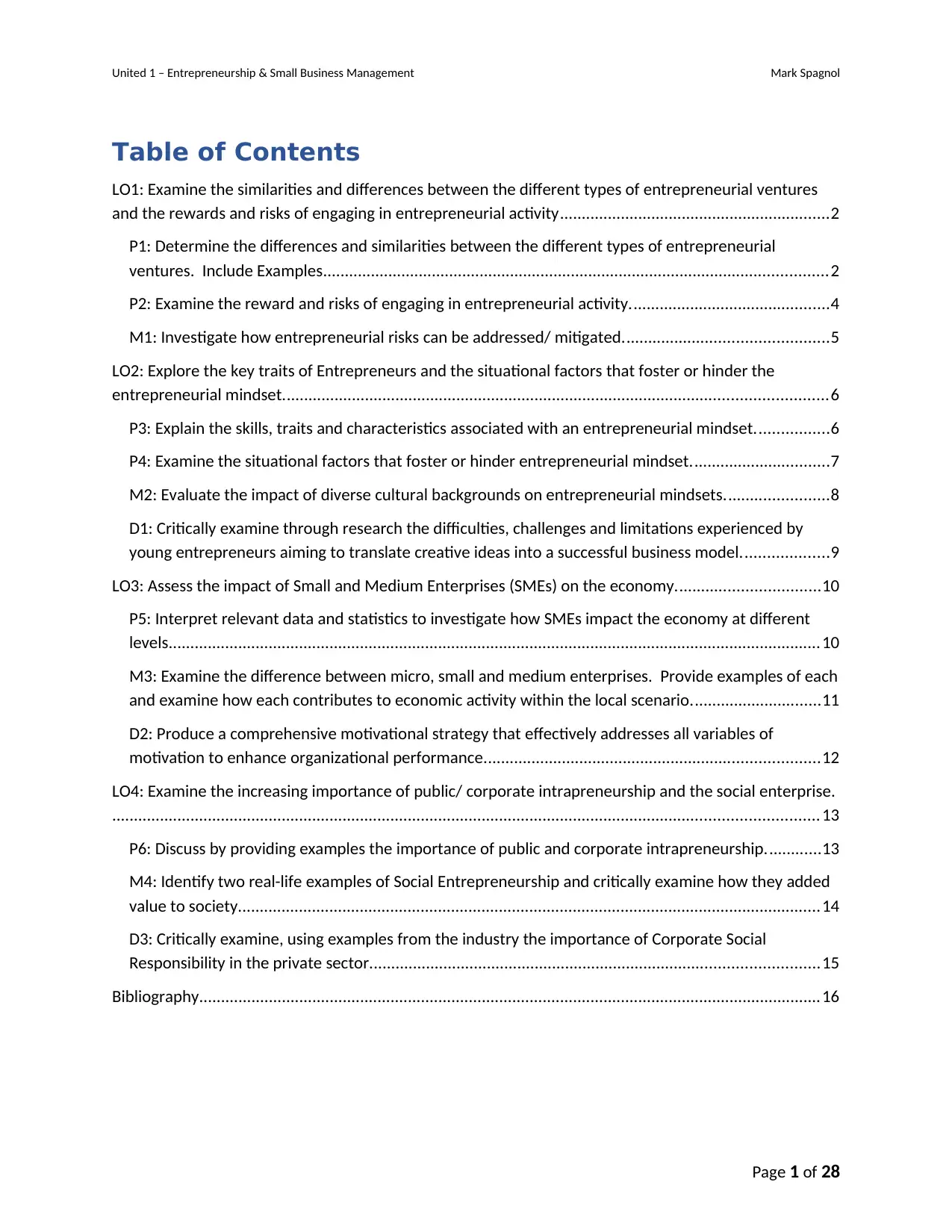
United 1 – Entrepreneurship & Small Business Management Mark Spagnol
Table of Contents
LO1: Examine the similarities and differences between the different types of entrepreneurial ventures
and the rewards and risks of engaging in entrepreneurial activity..............................................................2
P1: Determine the differences and similarities between the different types of entrepreneurial
ventures. Include Examples....................................................................................................................2
P2: Examine the reward and risks of engaging in entrepreneurial activity..............................................4
M1: Investigate how entrepreneurial risks can be addressed/ mitigated...............................................5
LO2: Explore the key traits of Entrepreneurs and the situational factors that foster or hinder the
entrepreneurial mindset.............................................................................................................................6
P3: Explain the skills, traits and characteristics associated with an entrepreneurial mindset.................6
P4: Examine the situational factors that foster or hinder entrepreneurial mindset................................7
M2: Evaluate the impact of diverse cultural backgrounds on entrepreneurial mindsets........................8
D1: Critically examine through research the difficulties, challenges and limitations experienced by
young entrepreneurs aiming to translate creative ideas into a successful business model....................9
LO3: Assess the impact of Small and Medium Enterprises (SMEs) on the economy.................................10
P5: Interpret relevant data and statistics to investigate how SMEs impact the economy at different
levels......................................................................................................................................................10
M3: Examine the difference between micro, small and medium enterprises. Provide examples of each
and examine how each contributes to economic activity within the local scenario..............................11
D2: Produce a comprehensive motivational strategy that effectively addresses all variables of
motivation to enhance organizational performance.............................................................................12
LO4: Examine the increasing importance of public/ corporate intrapreneurship and the social enterprise.
.................................................................................................................................................................. 13
P6: Discuss by providing examples the importance of public and corporate intrapreneurship.............13
M4: Identify two real-life examples of Social Entrepreneurship and critically examine how they added
value to society......................................................................................................................................14
D3: Critically examine, using examples from the industry the importance of Corporate Social
Responsibility in the private sector.......................................................................................................15
Bibliography...............................................................................................................................................16
Page 1 of 28
Table of Contents
LO1: Examine the similarities and differences between the different types of entrepreneurial ventures
and the rewards and risks of engaging in entrepreneurial activity..............................................................2
P1: Determine the differences and similarities between the different types of entrepreneurial
ventures. Include Examples....................................................................................................................2
P2: Examine the reward and risks of engaging in entrepreneurial activity..............................................4
M1: Investigate how entrepreneurial risks can be addressed/ mitigated...............................................5
LO2: Explore the key traits of Entrepreneurs and the situational factors that foster or hinder the
entrepreneurial mindset.............................................................................................................................6
P3: Explain the skills, traits and characteristics associated with an entrepreneurial mindset.................6
P4: Examine the situational factors that foster or hinder entrepreneurial mindset................................7
M2: Evaluate the impact of diverse cultural backgrounds on entrepreneurial mindsets........................8
D1: Critically examine through research the difficulties, challenges and limitations experienced by
young entrepreneurs aiming to translate creative ideas into a successful business model....................9
LO3: Assess the impact of Small and Medium Enterprises (SMEs) on the economy.................................10
P5: Interpret relevant data and statistics to investigate how SMEs impact the economy at different
levels......................................................................................................................................................10
M3: Examine the difference between micro, small and medium enterprises. Provide examples of each
and examine how each contributes to economic activity within the local scenario..............................11
D2: Produce a comprehensive motivational strategy that effectively addresses all variables of
motivation to enhance organizational performance.............................................................................12
LO4: Examine the increasing importance of public/ corporate intrapreneurship and the social enterprise.
.................................................................................................................................................................. 13
P6: Discuss by providing examples the importance of public and corporate intrapreneurship.............13
M4: Identify two real-life examples of Social Entrepreneurship and critically examine how they added
value to society......................................................................................................................................14
D3: Critically examine, using examples from the industry the importance of Corporate Social
Responsibility in the private sector.......................................................................................................15
Bibliography...............................................................................................................................................16
Page 1 of 28
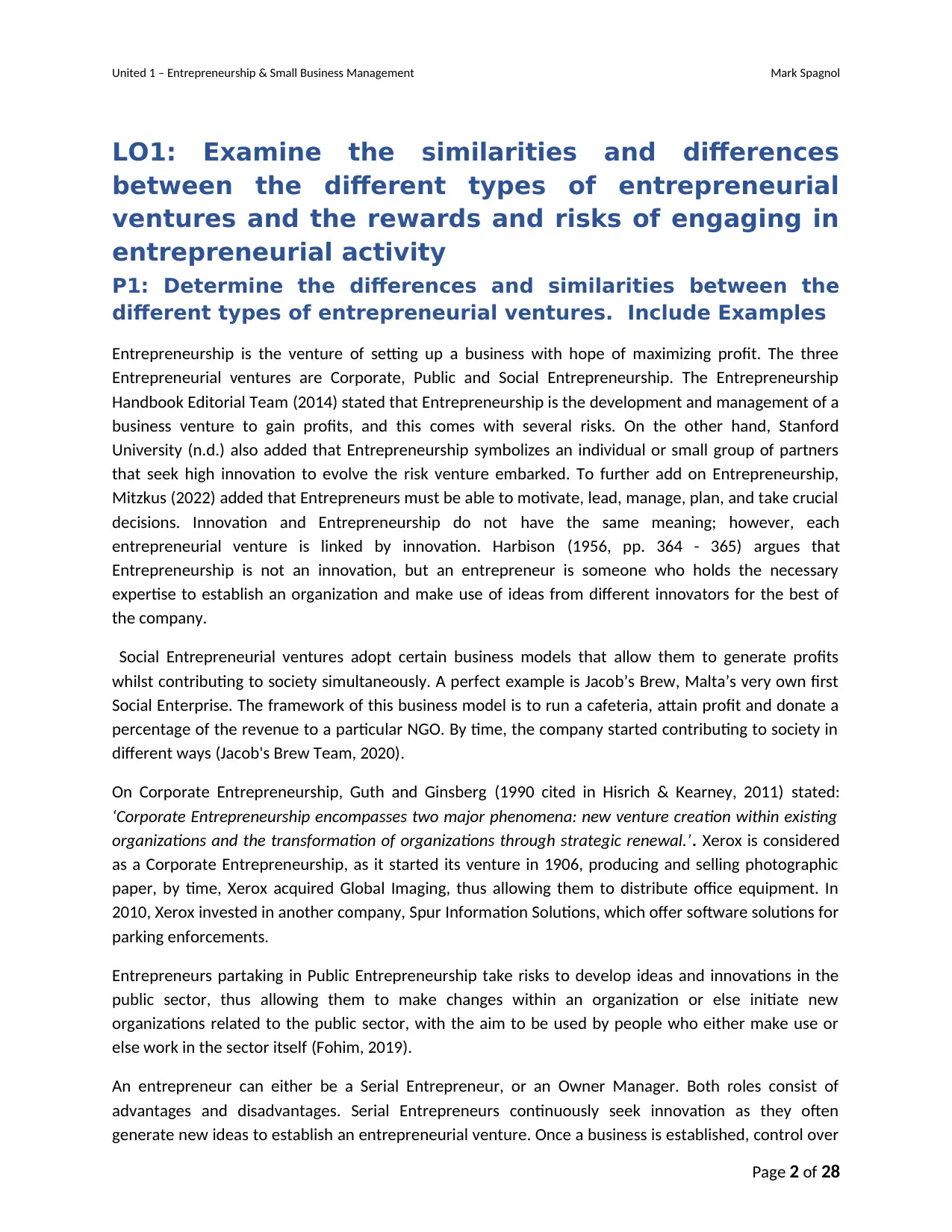
United 1 – Entrepreneurship & Small Business Management Mark Spagnol
LO1: Examine the similarities and differences
between the different types of entrepreneurial
ventures and the rewards and risks of engaging in
entrepreneurial activity
P1: Determine the differences and similarities between the
different types of entrepreneurial ventures. Include Examples
Entrepreneurship is the venture of setting up a business with hope of maximizing profit. The three
Entrepreneurial ventures are Corporate, Public and Social Entrepreneurship. The Entrepreneurship
Handbook Editorial Team (2014) stated that Entrepreneurship is the development and management of a
business venture to gain profits, and this comes with several risks. On the other hand, Stanford
University (n.d.) also added that Entrepreneurship symbolizes an individual or small group of partners
that seek high innovation to evolve the risk venture embarked. To further add on Entrepreneurship,
Mitzkus (2022) added that Entrepreneurs must be able to motivate, lead, manage, plan, and take crucial
decisions. Innovation and Entrepreneurship do not have the same meaning; however, each
entrepreneurial venture is linked by innovation. Harbison (1956, pp. 364 - 365) argues that
Entrepreneurship is not an innovation, but an entrepreneur is someone who holds the necessary
expertise to establish an organization and make use of ideas from different innovators for the best of
the company.
Social Entrepreneurial ventures adopt certain business models that allow them to generate profits
whilst contributing to society simultaneously. A perfect example is Jacob’s Brew, Malta’s very own first
Social Enterprise. The framework of this business model is to run a cafeteria, attain profit and donate a
percentage of the revenue to a particular NGO. By time, the company started contributing to society in
different ways (Jacob's Brew Team, 2020).
On Corporate Entrepreneurship, Guth and Ginsberg (1990 cited in Hisrich & Kearney, 2011) stated:
‘Corporate Entrepreneurship encompasses two major phenomena: new venture creation within existing
organizations and the transformation of organizations through strategic renewal.’. Xerox is considered
as a Corporate Entrepreneurship, as it started its venture in 1906, producing and selling photographic
paper, by time, Xerox acquired Global Imaging, thus allowing them to distribute office equipment. In
2010, Xerox invested in another company, Spur Information Solutions, which offer software solutions for
parking enforcements.
Entrepreneurs partaking in Public Entrepreneurship take risks to develop ideas and innovations in the
public sector, thus allowing them to make changes within an organization or else initiate new
organizations related to the public sector, with the aim to be used by people who either make use or
else work in the sector itself (Fohim, 2019).
An entrepreneur can either be a Serial Entrepreneur, or an Owner Manager. Both roles consist of
advantages and disadvantages. Serial Entrepreneurs continuously seek innovation as they often
generate new ideas to establish an entrepreneurial venture. Once a business is established, control over
Page 2 of 28
LO1: Examine the similarities and differences
between the different types of entrepreneurial
ventures and the rewards and risks of engaging in
entrepreneurial activity
P1: Determine the differences and similarities between the
different types of entrepreneurial ventures. Include Examples
Entrepreneurship is the venture of setting up a business with hope of maximizing profit. The three
Entrepreneurial ventures are Corporate, Public and Social Entrepreneurship. The Entrepreneurship
Handbook Editorial Team (2014) stated that Entrepreneurship is the development and management of a
business venture to gain profits, and this comes with several risks. On the other hand, Stanford
University (n.d.) also added that Entrepreneurship symbolizes an individual or small group of partners
that seek high innovation to evolve the risk venture embarked. To further add on Entrepreneurship,
Mitzkus (2022) added that Entrepreneurs must be able to motivate, lead, manage, plan, and take crucial
decisions. Innovation and Entrepreneurship do not have the same meaning; however, each
entrepreneurial venture is linked by innovation. Harbison (1956, pp. 364 - 365) argues that
Entrepreneurship is not an innovation, but an entrepreneur is someone who holds the necessary
expertise to establish an organization and make use of ideas from different innovators for the best of
the company.
Social Entrepreneurial ventures adopt certain business models that allow them to generate profits
whilst contributing to society simultaneously. A perfect example is Jacob’s Brew, Malta’s very own first
Social Enterprise. The framework of this business model is to run a cafeteria, attain profit and donate a
percentage of the revenue to a particular NGO. By time, the company started contributing to society in
different ways (Jacob's Brew Team, 2020).
On Corporate Entrepreneurship, Guth and Ginsberg (1990 cited in Hisrich & Kearney, 2011) stated:
‘Corporate Entrepreneurship encompasses two major phenomena: new venture creation within existing
organizations and the transformation of organizations through strategic renewal.’. Xerox is considered
as a Corporate Entrepreneurship, as it started its venture in 1906, producing and selling photographic
paper, by time, Xerox acquired Global Imaging, thus allowing them to distribute office equipment. In
2010, Xerox invested in another company, Spur Information Solutions, which offer software solutions for
parking enforcements.
Entrepreneurs partaking in Public Entrepreneurship take risks to develop ideas and innovations in the
public sector, thus allowing them to make changes within an organization or else initiate new
organizations related to the public sector, with the aim to be used by people who either make use or
else work in the sector itself (Fohim, 2019).
An entrepreneur can either be a Serial Entrepreneur, or an Owner Manager. Both roles consist of
advantages and disadvantages. Serial Entrepreneurs continuously seek innovation as they often
generate new ideas to establish an entrepreneurial venture. Once a business is established, control over
Page 2 of 28
⊘ This is a preview!⊘
Do you want full access?
Subscribe today to unlock all pages.

Trusted by 1+ million students worldwide
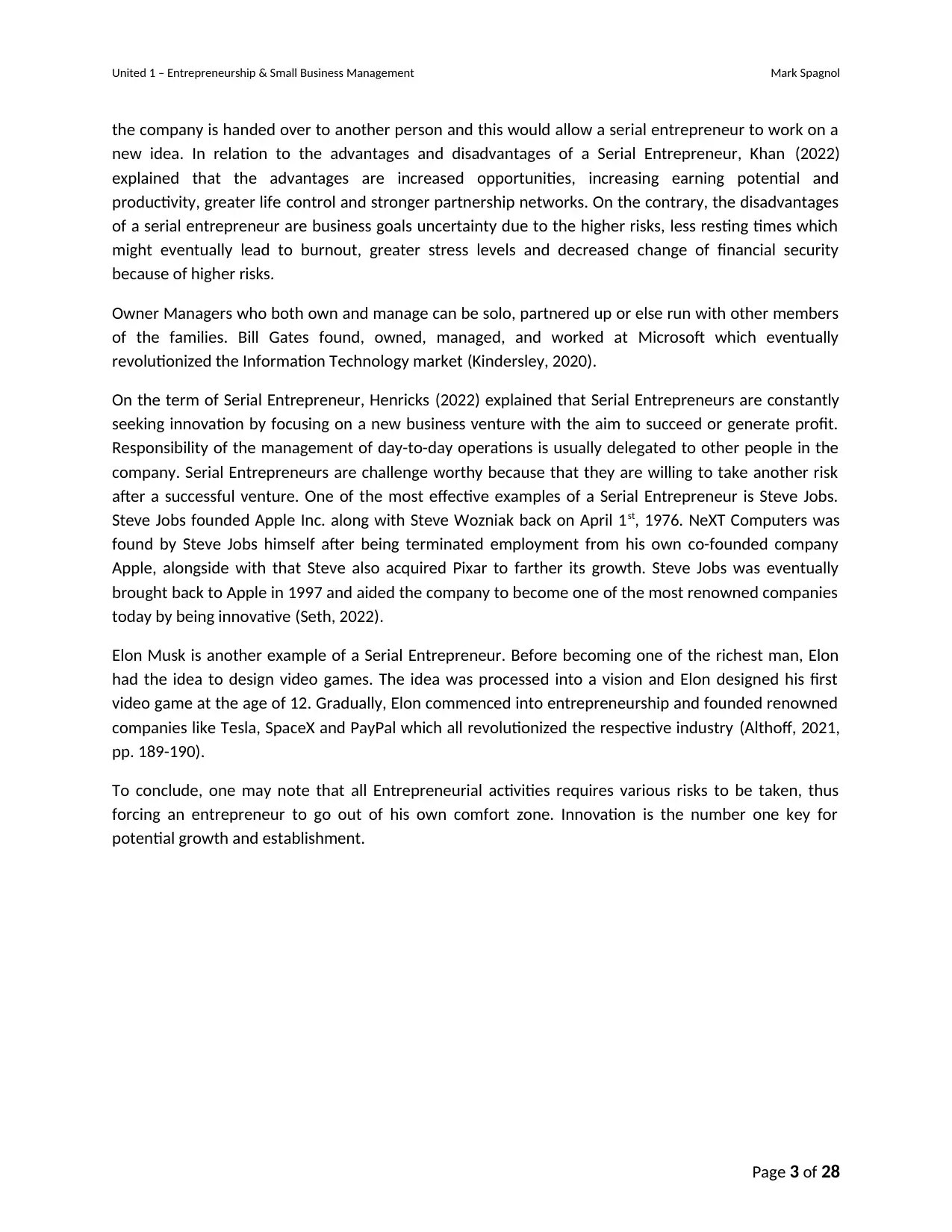
United 1 – Entrepreneurship & Small Business Management Mark Spagnol
the company is handed over to another person and this would allow a serial entrepreneur to work on a
new idea. In relation to the advantages and disadvantages of a Serial Entrepreneur, Khan (2022)
explained that the advantages are increased opportunities, increasing earning potential and
productivity, greater life control and stronger partnership networks. On the contrary, the disadvantages
of a serial entrepreneur are business goals uncertainty due to the higher risks, less resting times which
might eventually lead to burnout, greater stress levels and decreased change of financial security
because of higher risks.
Owner Managers who both own and manage can be solo, partnered up or else run with other members
of the families. Bill Gates found, owned, managed, and worked at Microsoft which eventually
revolutionized the Information Technology market (Kindersley, 2020).
On the term of Serial Entrepreneur, Henricks (2022) explained that Serial Entrepreneurs are constantly
seeking innovation by focusing on a new business venture with the aim to succeed or generate profit.
Responsibility of the management of day-to-day operations is usually delegated to other people in the
company. Serial Entrepreneurs are challenge worthy because that they are willing to take another risk
after a successful venture. One of the most effective examples of a Serial Entrepreneur is Steve Jobs.
Steve Jobs founded Apple Inc. along with Steve Wozniak back on April 1st, 1976. NeXT Computers was
found by Steve Jobs himself after being terminated employment from his own co-founded company
Apple, alongside with that Steve also acquired Pixar to farther its growth. Steve Jobs was eventually
brought back to Apple in 1997 and aided the company to become one of the most renowned companies
today by being innovative (Seth, 2022).
Elon Musk is another example of a Serial Entrepreneur. Before becoming one of the richest man, Elon
had the idea to design video games. The idea was processed into a vision and Elon designed his first
video game at the age of 12. Gradually, Elon commenced into entrepreneurship and founded renowned
companies like Tesla, SpaceX and PayPal which all revolutionized the respective industry (Althoff, 2021,
pp. 189-190).
To conclude, one may note that all Entrepreneurial activities requires various risks to be taken, thus
forcing an entrepreneur to go out of his own comfort zone. Innovation is the number one key for
potential growth and establishment.
Page 3 of 28
the company is handed over to another person and this would allow a serial entrepreneur to work on a
new idea. In relation to the advantages and disadvantages of a Serial Entrepreneur, Khan (2022)
explained that the advantages are increased opportunities, increasing earning potential and
productivity, greater life control and stronger partnership networks. On the contrary, the disadvantages
of a serial entrepreneur are business goals uncertainty due to the higher risks, less resting times which
might eventually lead to burnout, greater stress levels and decreased change of financial security
because of higher risks.
Owner Managers who both own and manage can be solo, partnered up or else run with other members
of the families. Bill Gates found, owned, managed, and worked at Microsoft which eventually
revolutionized the Information Technology market (Kindersley, 2020).
On the term of Serial Entrepreneur, Henricks (2022) explained that Serial Entrepreneurs are constantly
seeking innovation by focusing on a new business venture with the aim to succeed or generate profit.
Responsibility of the management of day-to-day operations is usually delegated to other people in the
company. Serial Entrepreneurs are challenge worthy because that they are willing to take another risk
after a successful venture. One of the most effective examples of a Serial Entrepreneur is Steve Jobs.
Steve Jobs founded Apple Inc. along with Steve Wozniak back on April 1st, 1976. NeXT Computers was
found by Steve Jobs himself after being terminated employment from his own co-founded company
Apple, alongside with that Steve also acquired Pixar to farther its growth. Steve Jobs was eventually
brought back to Apple in 1997 and aided the company to become one of the most renowned companies
today by being innovative (Seth, 2022).
Elon Musk is another example of a Serial Entrepreneur. Before becoming one of the richest man, Elon
had the idea to design video games. The idea was processed into a vision and Elon designed his first
video game at the age of 12. Gradually, Elon commenced into entrepreneurship and founded renowned
companies like Tesla, SpaceX and PayPal which all revolutionized the respective industry (Althoff, 2021,
pp. 189-190).
To conclude, one may note that all Entrepreneurial activities requires various risks to be taken, thus
forcing an entrepreneur to go out of his own comfort zone. Innovation is the number one key for
potential growth and establishment.
Page 3 of 28
Paraphrase This Document
Need a fresh take? Get an instant paraphrase of this document with our AI Paraphraser
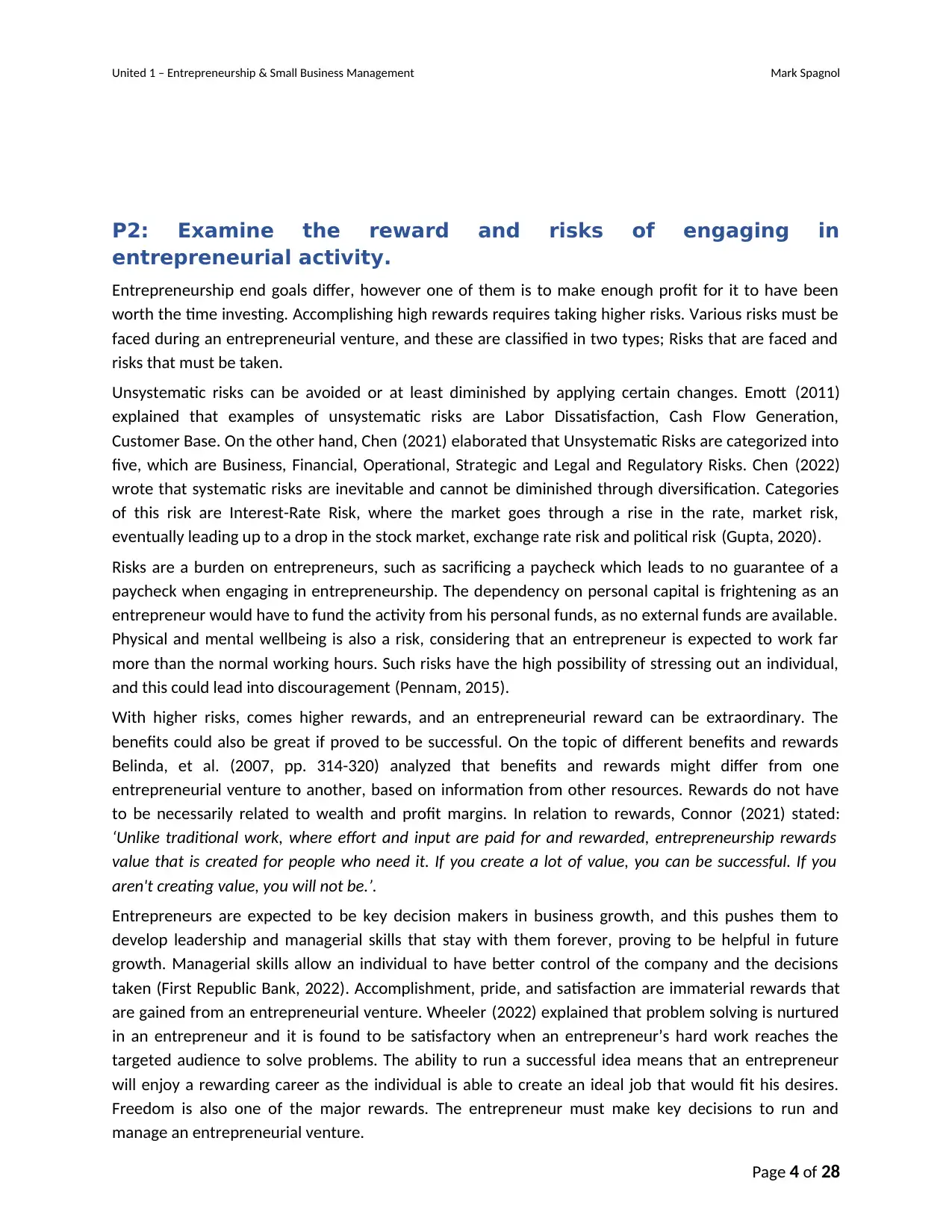
United 1 – Entrepreneurship & Small Business Management Mark Spagnol
P2: Examine the reward and risks of engaging in
entrepreneurial activity.
Entrepreneurship end goals differ, however one of them is to make enough profit for it to have been
worth the time investing. Accomplishing high rewards requires taking higher risks. Various risks must be
faced during an entrepreneurial venture, and these are classified in two types; Risks that are faced and
risks that must be taken.
Unsystematic risks can be avoided or at least diminished by applying certain changes. Emott (2011)
explained that examples of unsystematic risks are Labor Dissatisfaction, Cash Flow Generation,
Customer Base. On the other hand, Chen (2021) elaborated that Unsystematic Risks are categorized into
five, which are Business, Financial, Operational, Strategic and Legal and Regulatory Risks. Chen (2022)
wrote that systematic risks are inevitable and cannot be diminished through diversification. Categories
of this risk are Interest-Rate Risk, where the market goes through a rise in the rate, market risk,
eventually leading up to a drop in the stock market, exchange rate risk and political risk (Gupta, 2020).
Risks are a burden on entrepreneurs, such as sacrificing a paycheck which leads to no guarantee of a
paycheck when engaging in entrepreneurship. The dependency on personal capital is frightening as an
entrepreneur would have to fund the activity from his personal funds, as no external funds are available.
Physical and mental wellbeing is also a risk, considering that an entrepreneur is expected to work far
more than the normal working hours. Such risks have the high possibility of stressing out an individual,
and this could lead into discouragement (Pennam, 2015).
With higher risks, comes higher rewards, and an entrepreneurial reward can be extraordinary. The
benefits could also be great if proved to be successful. On the topic of different benefits and rewards
Belinda, et al. (2007, pp. 314-320) analyzed that benefits and rewards might differ from one
entrepreneurial venture to another, based on information from other resources. Rewards do not have
to be necessarily related to wealth and profit margins. In relation to rewards, Connor (2021) stated:
‘Unlike traditional work, where effort and input are paid for and rewarded, entrepreneurship rewards
value that is created for people who need it. If you create a lot of value, you can be successful. If you
aren't creating value, you will not be.’.
Entrepreneurs are expected to be key decision makers in business growth, and this pushes them to
develop leadership and managerial skills that stay with them forever, proving to be helpful in future
growth. Managerial skills allow an individual to have better control of the company and the decisions
taken (First Republic Bank, 2022). Accomplishment, pride, and satisfaction are immaterial rewards that
are gained from an entrepreneurial venture. Wheeler (2022) explained that problem solving is nurtured
in an entrepreneur and it is found to be satisfactory when an entrepreneur’s hard work reaches the
targeted audience to solve problems. The ability to run a successful idea means that an entrepreneur
will enjoy a rewarding career as the individual is able to create an ideal job that would fit his desires.
Freedom is also one of the major rewards. The entrepreneur must make key decisions to run and
manage an entrepreneurial venture.
Page 4 of 28
P2: Examine the reward and risks of engaging in
entrepreneurial activity.
Entrepreneurship end goals differ, however one of them is to make enough profit for it to have been
worth the time investing. Accomplishing high rewards requires taking higher risks. Various risks must be
faced during an entrepreneurial venture, and these are classified in two types; Risks that are faced and
risks that must be taken.
Unsystematic risks can be avoided or at least diminished by applying certain changes. Emott (2011)
explained that examples of unsystematic risks are Labor Dissatisfaction, Cash Flow Generation,
Customer Base. On the other hand, Chen (2021) elaborated that Unsystematic Risks are categorized into
five, which are Business, Financial, Operational, Strategic and Legal and Regulatory Risks. Chen (2022)
wrote that systematic risks are inevitable and cannot be diminished through diversification. Categories
of this risk are Interest-Rate Risk, where the market goes through a rise in the rate, market risk,
eventually leading up to a drop in the stock market, exchange rate risk and political risk (Gupta, 2020).
Risks are a burden on entrepreneurs, such as sacrificing a paycheck which leads to no guarantee of a
paycheck when engaging in entrepreneurship. The dependency on personal capital is frightening as an
entrepreneur would have to fund the activity from his personal funds, as no external funds are available.
Physical and mental wellbeing is also a risk, considering that an entrepreneur is expected to work far
more than the normal working hours. Such risks have the high possibility of stressing out an individual,
and this could lead into discouragement (Pennam, 2015).
With higher risks, comes higher rewards, and an entrepreneurial reward can be extraordinary. The
benefits could also be great if proved to be successful. On the topic of different benefits and rewards
Belinda, et al. (2007, pp. 314-320) analyzed that benefits and rewards might differ from one
entrepreneurial venture to another, based on information from other resources. Rewards do not have
to be necessarily related to wealth and profit margins. In relation to rewards, Connor (2021) stated:
‘Unlike traditional work, where effort and input are paid for and rewarded, entrepreneurship rewards
value that is created for people who need it. If you create a lot of value, you can be successful. If you
aren't creating value, you will not be.’.
Entrepreneurs are expected to be key decision makers in business growth, and this pushes them to
develop leadership and managerial skills that stay with them forever, proving to be helpful in future
growth. Managerial skills allow an individual to have better control of the company and the decisions
taken (First Republic Bank, 2022). Accomplishment, pride, and satisfaction are immaterial rewards that
are gained from an entrepreneurial venture. Wheeler (2022) explained that problem solving is nurtured
in an entrepreneur and it is found to be satisfactory when an entrepreneur’s hard work reaches the
targeted audience to solve problems. The ability to run a successful idea means that an entrepreneur
will enjoy a rewarding career as the individual is able to create an ideal job that would fit his desires.
Freedom is also one of the major rewards. The entrepreneur must make key decisions to run and
manage an entrepreneurial venture.
Page 4 of 28
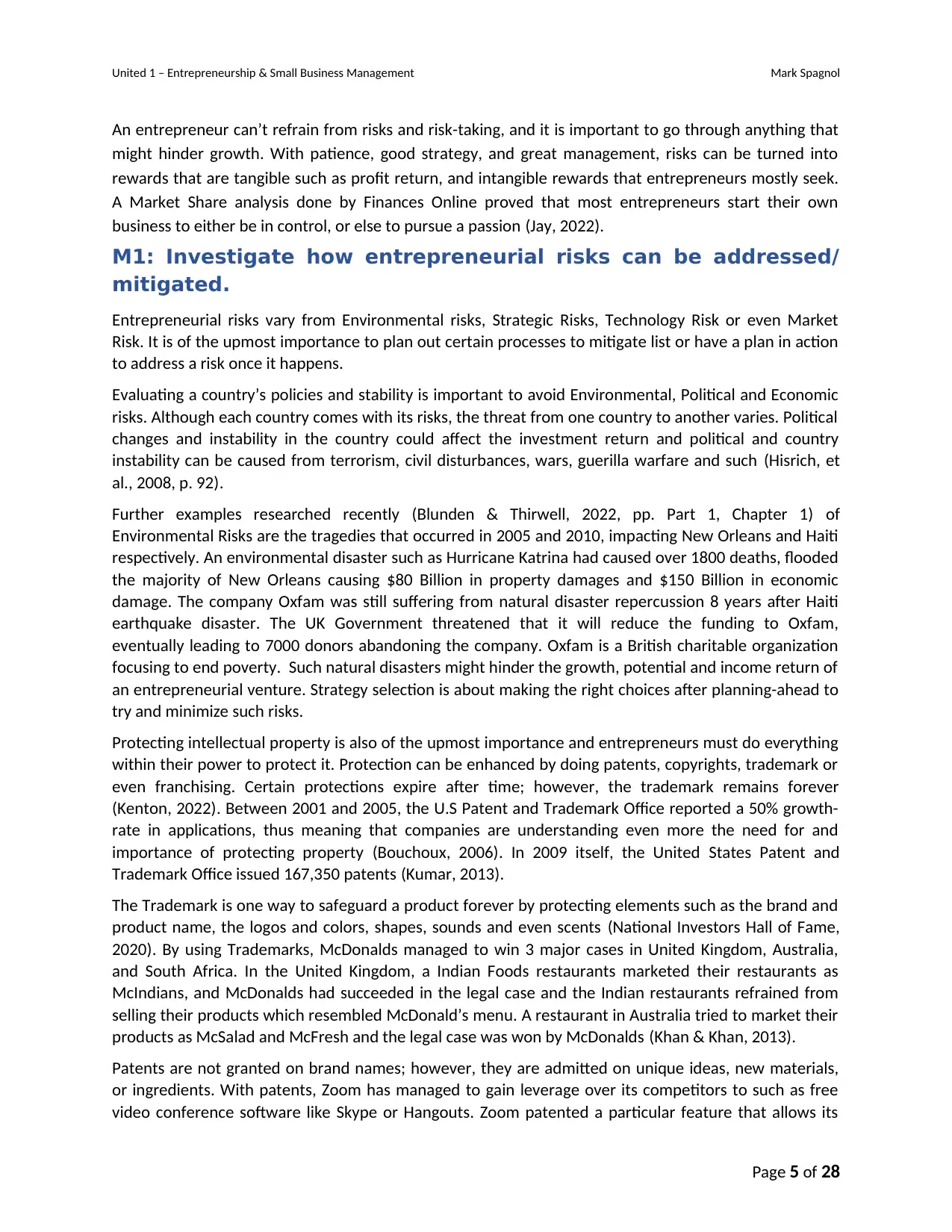
United 1 – Entrepreneurship & Small Business Management Mark Spagnol
An entrepreneur can’t refrain from risks and risk-taking, and it is important to go through anything that
might hinder growth. With patience, good strategy, and great management, risks can be turned into
rewards that are tangible such as profit return, and intangible rewards that entrepreneurs mostly seek.
A Market Share analysis done by Finances Online proved that most entrepreneurs start their own
business to either be in control, or else to pursue a passion (Jay, 2022).
M1: Investigate how entrepreneurial risks can be addressed/
mitigated.
Entrepreneurial risks vary from Environmental risks, Strategic Risks, Technology Risk or even Market
Risk. It is of the upmost importance to plan out certain processes to mitigate list or have a plan in action
to address a risk once it happens.
Evaluating a country’s policies and stability is important to avoid Environmental, Political and Economic
risks. Although each country comes with its risks, the threat from one country to another varies. Political
changes and instability in the country could affect the investment return and political and country
instability can be caused from terrorism, civil disturbances, wars, guerilla warfare and such (Hisrich, et
al., 2008, p. 92).
Further examples researched recently (Blunden & Thirwell, 2022, pp. Part 1, Chapter 1) of
Environmental Risks are the tragedies that occurred in 2005 and 2010, impacting New Orleans and Haiti
respectively. An environmental disaster such as Hurricane Katrina had caused over 1800 deaths, flooded
the majority of New Orleans causing $80 Billion in property damages and $150 Billion in economic
damage. The company Oxfam was still suffering from natural disaster repercussion 8 years after Haiti
earthquake disaster. The UK Government threatened that it will reduce the funding to Oxfam,
eventually leading to 7000 donors abandoning the company. Oxfam is a British charitable organization
focusing to end poverty. Such natural disasters might hinder the growth, potential and income return of
an entrepreneurial venture. Strategy selection is about making the right choices after planning-ahead to
try and minimize such risks.
Protecting intellectual property is also of the upmost importance and entrepreneurs must do everything
within their power to protect it. Protection can be enhanced by doing patents, copyrights, trademark or
even franchising. Certain protections expire after time; however, the trademark remains forever
(Kenton, 2022). Between 2001 and 2005, the U.S Patent and Trademark Office reported a 50% growth-
rate in applications, thus meaning that companies are understanding even more the need for and
importance of protecting property (Bouchoux, 2006). In 2009 itself, the United States Patent and
Trademark Office issued 167,350 patents (Kumar, 2013).
The Trademark is one way to safeguard a product forever by protecting elements such as the brand and
product name, the logos and colors, shapes, sounds and even scents (National Investors Hall of Fame,
2020). By using Trademarks, McDonalds managed to win 3 major cases in United Kingdom, Australia,
and South Africa. In the United Kingdom, a Indian Foods restaurants marketed their restaurants as
McIndians, and McDonalds had succeeded in the legal case and the Indian restaurants refrained from
selling their products which resembled McDonald’s menu. A restaurant in Australia tried to market their
products as McSalad and McFresh and the legal case was won by McDonalds (Khan & Khan, 2013).
Patents are not granted on brand names; however, they are admitted on unique ideas, new materials,
or ingredients. With patents, Zoom has managed to gain leverage over its competitors to such as free
video conference software like Skype or Hangouts. Zoom patented a particular feature that allows its
Page 5 of 28
An entrepreneur can’t refrain from risks and risk-taking, and it is important to go through anything that
might hinder growth. With patience, good strategy, and great management, risks can be turned into
rewards that are tangible such as profit return, and intangible rewards that entrepreneurs mostly seek.
A Market Share analysis done by Finances Online proved that most entrepreneurs start their own
business to either be in control, or else to pursue a passion (Jay, 2022).
M1: Investigate how entrepreneurial risks can be addressed/
mitigated.
Entrepreneurial risks vary from Environmental risks, Strategic Risks, Technology Risk or even Market
Risk. It is of the upmost importance to plan out certain processes to mitigate list or have a plan in action
to address a risk once it happens.
Evaluating a country’s policies and stability is important to avoid Environmental, Political and Economic
risks. Although each country comes with its risks, the threat from one country to another varies. Political
changes and instability in the country could affect the investment return and political and country
instability can be caused from terrorism, civil disturbances, wars, guerilla warfare and such (Hisrich, et
al., 2008, p. 92).
Further examples researched recently (Blunden & Thirwell, 2022, pp. Part 1, Chapter 1) of
Environmental Risks are the tragedies that occurred in 2005 and 2010, impacting New Orleans and Haiti
respectively. An environmental disaster such as Hurricane Katrina had caused over 1800 deaths, flooded
the majority of New Orleans causing $80 Billion in property damages and $150 Billion in economic
damage. The company Oxfam was still suffering from natural disaster repercussion 8 years after Haiti
earthquake disaster. The UK Government threatened that it will reduce the funding to Oxfam,
eventually leading to 7000 donors abandoning the company. Oxfam is a British charitable organization
focusing to end poverty. Such natural disasters might hinder the growth, potential and income return of
an entrepreneurial venture. Strategy selection is about making the right choices after planning-ahead to
try and minimize such risks.
Protecting intellectual property is also of the upmost importance and entrepreneurs must do everything
within their power to protect it. Protection can be enhanced by doing patents, copyrights, trademark or
even franchising. Certain protections expire after time; however, the trademark remains forever
(Kenton, 2022). Between 2001 and 2005, the U.S Patent and Trademark Office reported a 50% growth-
rate in applications, thus meaning that companies are understanding even more the need for and
importance of protecting property (Bouchoux, 2006). In 2009 itself, the United States Patent and
Trademark Office issued 167,350 patents (Kumar, 2013).
The Trademark is one way to safeguard a product forever by protecting elements such as the brand and
product name, the logos and colors, shapes, sounds and even scents (National Investors Hall of Fame,
2020). By using Trademarks, McDonalds managed to win 3 major cases in United Kingdom, Australia,
and South Africa. In the United Kingdom, a Indian Foods restaurants marketed their restaurants as
McIndians, and McDonalds had succeeded in the legal case and the Indian restaurants refrained from
selling their products which resembled McDonald’s menu. A restaurant in Australia tried to market their
products as McSalad and McFresh and the legal case was won by McDonalds (Khan & Khan, 2013).
Patents are not granted on brand names; however, they are admitted on unique ideas, new materials,
or ingredients. With patents, Zoom has managed to gain leverage over its competitors to such as free
video conference software like Skype or Hangouts. Zoom patented a particular feature that allows its
Page 5 of 28
⊘ This is a preview!⊘
Do you want full access?
Subscribe today to unlock all pages.

Trusted by 1+ million students worldwide
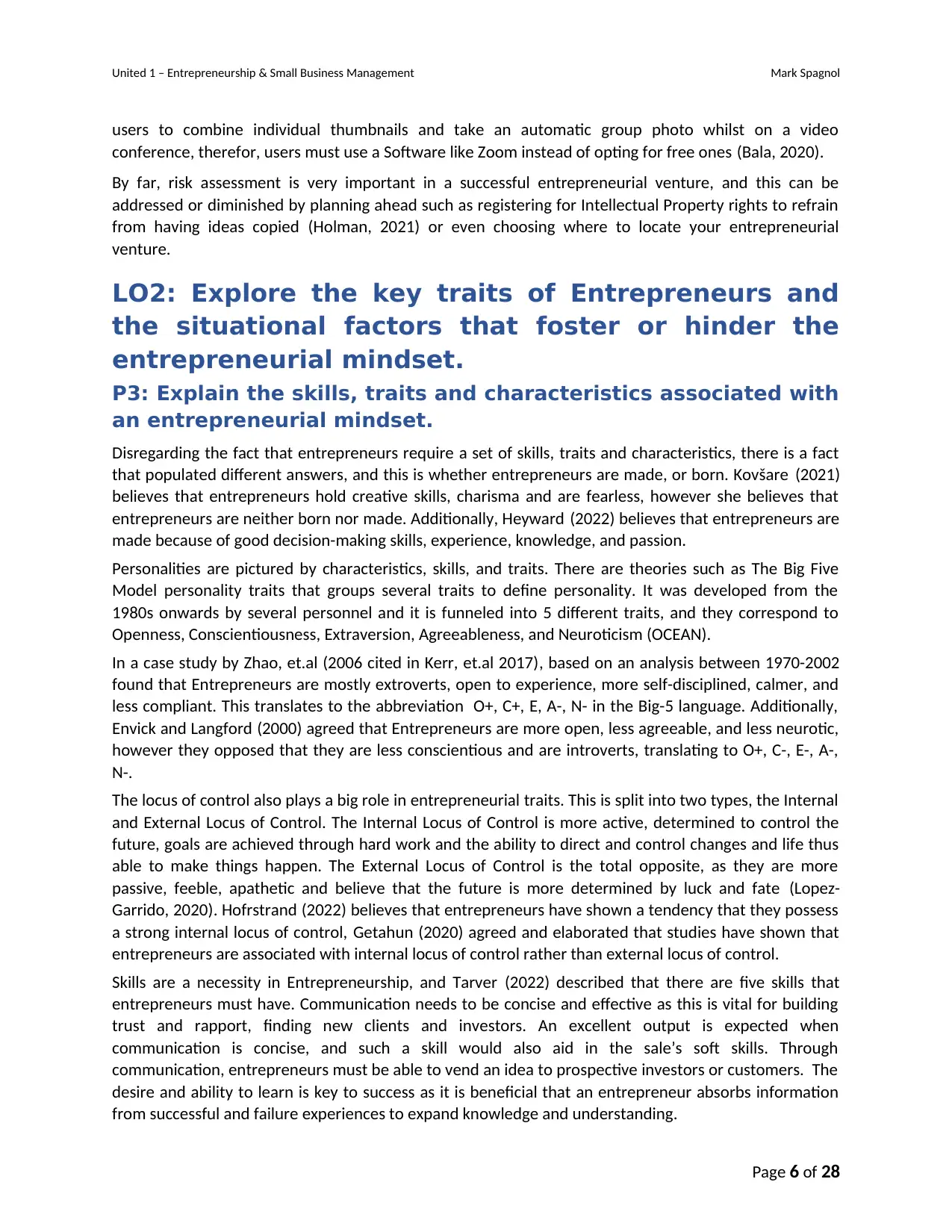
United 1 – Entrepreneurship & Small Business Management Mark Spagnol
users to combine individual thumbnails and take an automatic group photo whilst on a video
conference, therefor, users must use a Software like Zoom instead of opting for free ones (Bala, 2020).
By far, risk assessment is very important in a successful entrepreneurial venture, and this can be
addressed or diminished by planning ahead such as registering for Intellectual Property rights to refrain
from having ideas copied (Holman, 2021) or even choosing where to locate your entrepreneurial
venture.
LO2: Explore the key traits of Entrepreneurs and
the situational factors that foster or hinder the
entrepreneurial mindset.
P3: Explain the skills, traits and characteristics associated with
an entrepreneurial mindset.
Disregarding the fact that entrepreneurs require a set of skills, traits and characteristics, there is a fact
that populated different answers, and this is whether entrepreneurs are made, or born. Kovšare (2021)
believes that entrepreneurs hold creative skills, charisma and are fearless, however she believes that
entrepreneurs are neither born nor made. Additionally, Heyward (2022) believes that entrepreneurs are
made because of good decision-making skills, experience, knowledge, and passion.
Personalities are pictured by characteristics, skills, and traits. There are theories such as The Big Five
Model personality traits that groups several traits to define personality. It was developed from the
1980s onwards by several personnel and it is funneled into 5 different traits, and they correspond to
Openness, Conscientiousness, Extraversion, Agreeableness, and Neuroticism (OCEAN).
In a case study by Zhao, et.al (2006 cited in Kerr, et.al 2017), based on an analysis between 1970-2002
found that Entrepreneurs are mostly extroverts, open to experience, more self-disciplined, calmer, and
less compliant. This translates to the abbreviation O+, C+, E, A-, N- in the Big-5 language. Additionally,
Envick and Langford (2000) agreed that Entrepreneurs are more open, less agreeable, and less neurotic,
however they opposed that they are less conscientious and are introverts, translating to O+, C-, E-, A-,
N-.
The locus of control also plays a big role in entrepreneurial traits. This is split into two types, the Internal
and External Locus of Control. The Internal Locus of Control is more active, determined to control the
future, goals are achieved through hard work and the ability to direct and control changes and life thus
able to make things happen. The External Locus of Control is the total opposite, as they are more
passive, feeble, apathetic and believe that the future is more determined by luck and fate (Lopez-
Garrido, 2020). Hofrstrand (2022) believes that entrepreneurs have shown a tendency that they possess
a strong internal locus of control, Getahun (2020) agreed and elaborated that studies have shown that
entrepreneurs are associated with internal locus of control rather than external locus of control.
Skills are a necessity in Entrepreneurship, and Tarver (2022) described that there are five skills that
entrepreneurs must have. Communication needs to be concise and effective as this is vital for building
trust and rapport, finding new clients and investors. An excellent output is expected when
communication is concise, and such a skill would also aid in the sale’s soft skills. Through
communication, entrepreneurs must be able to vend an idea to prospective investors or customers. The
desire and ability to learn is key to success as it is beneficial that an entrepreneur absorbs information
from successful and failure experiences to expand knowledge and understanding.
Page 6 of 28
users to combine individual thumbnails and take an automatic group photo whilst on a video
conference, therefor, users must use a Software like Zoom instead of opting for free ones (Bala, 2020).
By far, risk assessment is very important in a successful entrepreneurial venture, and this can be
addressed or diminished by planning ahead such as registering for Intellectual Property rights to refrain
from having ideas copied (Holman, 2021) or even choosing where to locate your entrepreneurial
venture.
LO2: Explore the key traits of Entrepreneurs and
the situational factors that foster or hinder the
entrepreneurial mindset.
P3: Explain the skills, traits and characteristics associated with
an entrepreneurial mindset.
Disregarding the fact that entrepreneurs require a set of skills, traits and characteristics, there is a fact
that populated different answers, and this is whether entrepreneurs are made, or born. Kovšare (2021)
believes that entrepreneurs hold creative skills, charisma and are fearless, however she believes that
entrepreneurs are neither born nor made. Additionally, Heyward (2022) believes that entrepreneurs are
made because of good decision-making skills, experience, knowledge, and passion.
Personalities are pictured by characteristics, skills, and traits. There are theories such as The Big Five
Model personality traits that groups several traits to define personality. It was developed from the
1980s onwards by several personnel and it is funneled into 5 different traits, and they correspond to
Openness, Conscientiousness, Extraversion, Agreeableness, and Neuroticism (OCEAN).
In a case study by Zhao, et.al (2006 cited in Kerr, et.al 2017), based on an analysis between 1970-2002
found that Entrepreneurs are mostly extroverts, open to experience, more self-disciplined, calmer, and
less compliant. This translates to the abbreviation O+, C+, E, A-, N- in the Big-5 language. Additionally,
Envick and Langford (2000) agreed that Entrepreneurs are more open, less agreeable, and less neurotic,
however they opposed that they are less conscientious and are introverts, translating to O+, C-, E-, A-,
N-.
The locus of control also plays a big role in entrepreneurial traits. This is split into two types, the Internal
and External Locus of Control. The Internal Locus of Control is more active, determined to control the
future, goals are achieved through hard work and the ability to direct and control changes and life thus
able to make things happen. The External Locus of Control is the total opposite, as they are more
passive, feeble, apathetic and believe that the future is more determined by luck and fate (Lopez-
Garrido, 2020). Hofrstrand (2022) believes that entrepreneurs have shown a tendency that they possess
a strong internal locus of control, Getahun (2020) agreed and elaborated that studies have shown that
entrepreneurs are associated with internal locus of control rather than external locus of control.
Skills are a necessity in Entrepreneurship, and Tarver (2022) described that there are five skills that
entrepreneurs must have. Communication needs to be concise and effective as this is vital for building
trust and rapport, finding new clients and investors. An excellent output is expected when
communication is concise, and such a skill would also aid in the sale’s soft skills. Through
communication, entrepreneurs must be able to vend an idea to prospective investors or customers. The
desire and ability to learn is key to success as it is beneficial that an entrepreneur absorbs information
from successful and failure experiences to expand knowledge and understanding.
Page 6 of 28
Paraphrase This Document
Need a fresh take? Get an instant paraphrase of this document with our AI Paraphraser
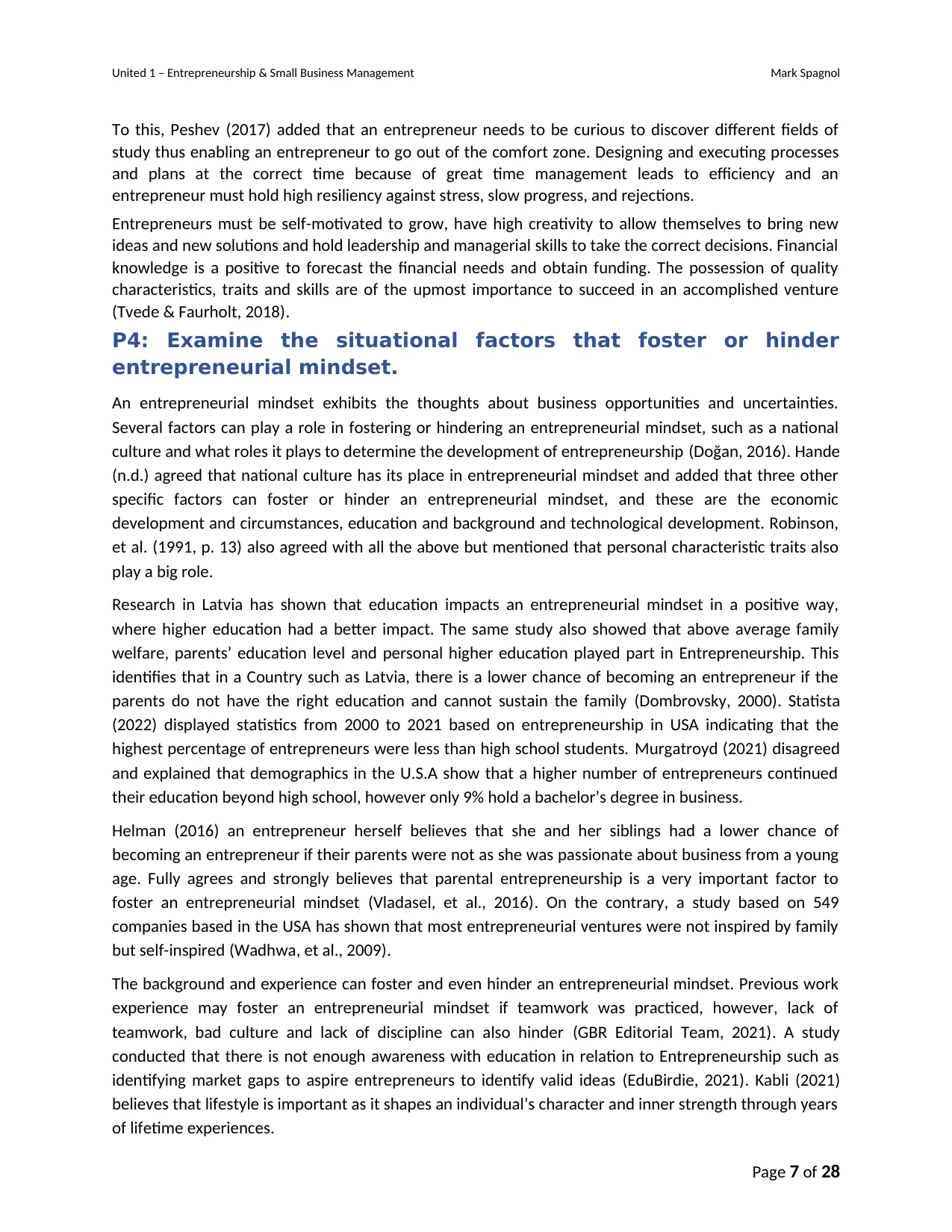
United 1 – Entrepreneurship & Small Business Management Mark Spagnol
To this, Peshev (2017) added that an entrepreneur needs to be curious to discover different fields of
study thus enabling an entrepreneur to go out of the comfort zone. Designing and executing processes
and plans at the correct time because of great time management leads to efficiency and an
entrepreneur must hold high resiliency against stress, slow progress, and rejections.
Entrepreneurs must be self-motivated to grow, have high creativity to allow themselves to bring new
ideas and new solutions and hold leadership and managerial skills to take the correct decisions. Financial
knowledge is a positive to forecast the financial needs and obtain funding. The possession of quality
characteristics, traits and skills are of the upmost importance to succeed in an accomplished venture
(Tvede & Faurholt, 2018).
P4: Examine the situational factors that foster or hinder
entrepreneurial mindset.
An entrepreneurial mindset exhibits the thoughts about business opportunities and uncertainties.
Several factors can play a role in fostering or hindering an entrepreneurial mindset, such as a national
culture and what roles it plays to determine the development of entrepreneurship (Doğan, 2016). Hande
(n.d.) agreed that national culture has its place in entrepreneurial mindset and added that three other
specific factors can foster or hinder an entrepreneurial mindset, and these are the economic
development and circumstances, education and background and technological development. Robinson,
et al. (1991, p. 13) also agreed with all the above but mentioned that personal characteristic traits also
play a big role.
Research in Latvia has shown that education impacts an entrepreneurial mindset in a positive way,
where higher education had a better impact. The same study also showed that above average family
welfare, parents’ education level and personal higher education played part in Entrepreneurship. This
identifies that in a Country such as Latvia, there is a lower chance of becoming an entrepreneur if the
parents do not have the right education and cannot sustain the family (Dombrovsky, 2000). Statista
(2022) displayed statistics from 2000 to 2021 based on entrepreneurship in USA indicating that the
highest percentage of entrepreneurs were less than high school students. Murgatroyd (2021) disagreed
and explained that demographics in the U.S.A show that a higher number of entrepreneurs continued
their education beyond high school, however only 9% hold a bachelor’s degree in business.
Helman (2016) an entrepreneur herself believes that she and her siblings had a lower chance of
becoming an entrepreneur if their parents were not as she was passionate about business from a young
age. Fully agrees and strongly believes that parental entrepreneurship is a very important factor to
foster an entrepreneurial mindset (Vladasel, et al., 2016). On the contrary, a study based on 549
companies based in the USA has shown that most entrepreneurial ventures were not inspired by family
but self-inspired (Wadhwa, et al., 2009).
The background and experience can foster and even hinder an entrepreneurial mindset. Previous work
experience may foster an entrepreneurial mindset if teamwork was practiced, however, lack of
teamwork, bad culture and lack of discipline can also hinder (GBR Editorial Team, 2021). A study
conducted that there is not enough awareness with education in relation to Entrepreneurship such as
identifying market gaps to aspire entrepreneurs to identify valid ideas (EduBirdie, 2021). Kabli (2021)
believes that lifestyle is important as it shapes an individual’s character and inner strength through years
of lifetime experiences.
Page 7 of 28
To this, Peshev (2017) added that an entrepreneur needs to be curious to discover different fields of
study thus enabling an entrepreneur to go out of the comfort zone. Designing and executing processes
and plans at the correct time because of great time management leads to efficiency and an
entrepreneur must hold high resiliency against stress, slow progress, and rejections.
Entrepreneurs must be self-motivated to grow, have high creativity to allow themselves to bring new
ideas and new solutions and hold leadership and managerial skills to take the correct decisions. Financial
knowledge is a positive to forecast the financial needs and obtain funding. The possession of quality
characteristics, traits and skills are of the upmost importance to succeed in an accomplished venture
(Tvede & Faurholt, 2018).
P4: Examine the situational factors that foster or hinder
entrepreneurial mindset.
An entrepreneurial mindset exhibits the thoughts about business opportunities and uncertainties.
Several factors can play a role in fostering or hindering an entrepreneurial mindset, such as a national
culture and what roles it plays to determine the development of entrepreneurship (Doğan, 2016). Hande
(n.d.) agreed that national culture has its place in entrepreneurial mindset and added that three other
specific factors can foster or hinder an entrepreneurial mindset, and these are the economic
development and circumstances, education and background and technological development. Robinson,
et al. (1991, p. 13) also agreed with all the above but mentioned that personal characteristic traits also
play a big role.
Research in Latvia has shown that education impacts an entrepreneurial mindset in a positive way,
where higher education had a better impact. The same study also showed that above average family
welfare, parents’ education level and personal higher education played part in Entrepreneurship. This
identifies that in a Country such as Latvia, there is a lower chance of becoming an entrepreneur if the
parents do not have the right education and cannot sustain the family (Dombrovsky, 2000). Statista
(2022) displayed statistics from 2000 to 2021 based on entrepreneurship in USA indicating that the
highest percentage of entrepreneurs were less than high school students. Murgatroyd (2021) disagreed
and explained that demographics in the U.S.A show that a higher number of entrepreneurs continued
their education beyond high school, however only 9% hold a bachelor’s degree in business.
Helman (2016) an entrepreneur herself believes that she and her siblings had a lower chance of
becoming an entrepreneur if their parents were not as she was passionate about business from a young
age. Fully agrees and strongly believes that parental entrepreneurship is a very important factor to
foster an entrepreneurial mindset (Vladasel, et al., 2016). On the contrary, a study based on 549
companies based in the USA has shown that most entrepreneurial ventures were not inspired by family
but self-inspired (Wadhwa, et al., 2009).
The background and experience can foster and even hinder an entrepreneurial mindset. Previous work
experience may foster an entrepreneurial mindset if teamwork was practiced, however, lack of
teamwork, bad culture and lack of discipline can also hinder (GBR Editorial Team, 2021). A study
conducted that there is not enough awareness with education in relation to Entrepreneurship such as
identifying market gaps to aspire entrepreneurs to identify valid ideas (EduBirdie, 2021). Kabli (2021)
believes that lifestyle is important as it shapes an individual’s character and inner strength through years
of lifetime experiences.
Page 7 of 28
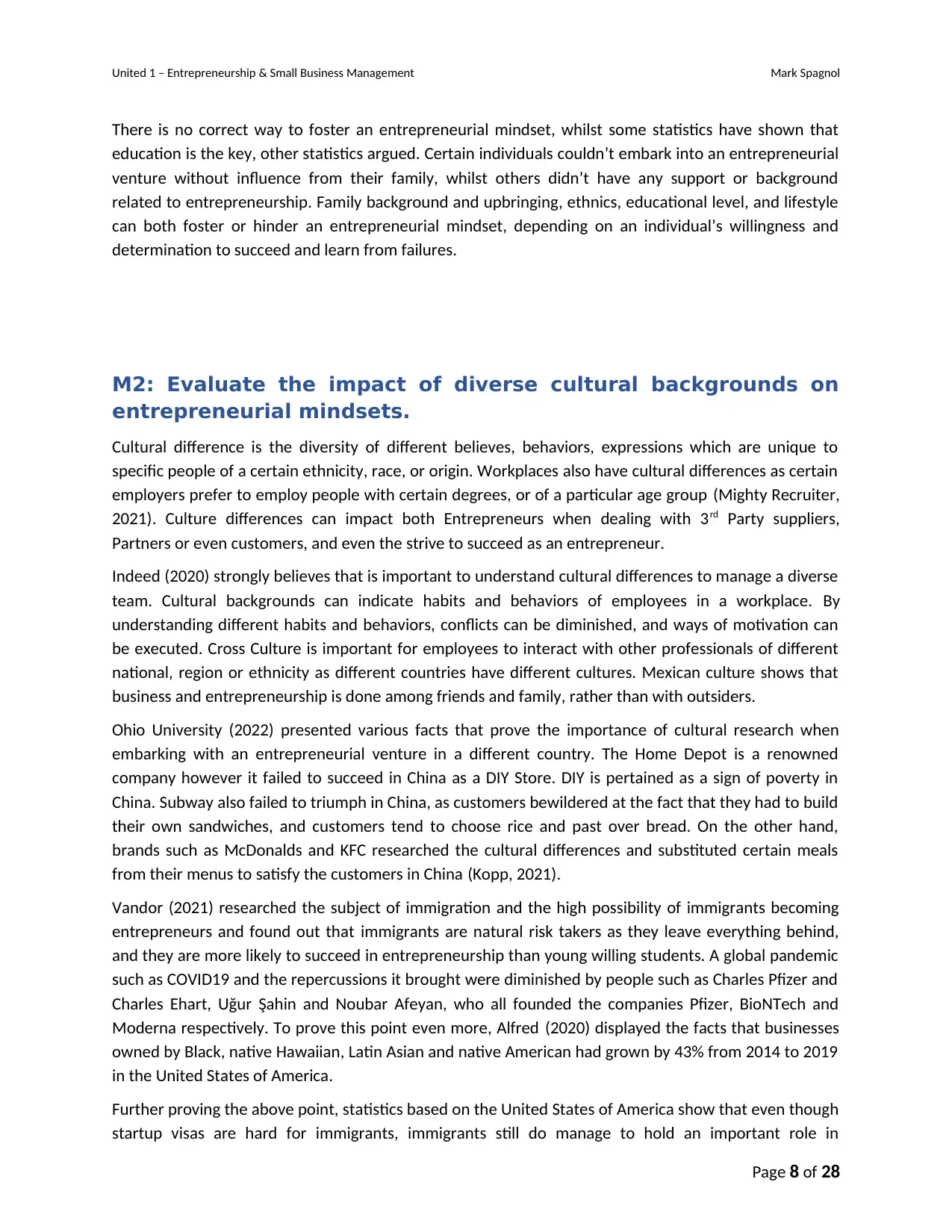
United 1 – Entrepreneurship & Small Business Management Mark Spagnol
There is no correct way to foster an entrepreneurial mindset, whilst some statistics have shown that
education is the key, other statistics argued. Certain individuals couldn’t embark into an entrepreneurial
venture without influence from their family, whilst others didn’t have any support or background
related to entrepreneurship. Family background and upbringing, ethnics, educational level, and lifestyle
can both foster or hinder an entrepreneurial mindset, depending on an individual’s willingness and
determination to succeed and learn from failures.
M2: Evaluate the impact of diverse cultural backgrounds on
entrepreneurial mindsets.
Cultural difference is the diversity of different believes, behaviors, expressions which are unique to
specific people of a certain ethnicity, race, or origin. Workplaces also have cultural differences as certain
employers prefer to employ people with certain degrees, or of a particular age group (Mighty Recruiter,
2021). Culture differences can impact both Entrepreneurs when dealing with 3rd Party suppliers,
Partners or even customers, and even the strive to succeed as an entrepreneur.
Indeed (2020) strongly believes that is important to understand cultural differences to manage a diverse
team. Cultural backgrounds can indicate habits and behaviors of employees in a workplace. By
understanding different habits and behaviors, conflicts can be diminished, and ways of motivation can
be executed. Cross Culture is important for employees to interact with other professionals of different
national, region or ethnicity as different countries have different cultures. Mexican culture shows that
business and entrepreneurship is done among friends and family, rather than with outsiders.
Ohio University (2022) presented various facts that prove the importance of cultural research when
embarking with an entrepreneurial venture in a different country. The Home Depot is a renowned
company however it failed to succeed in China as a DIY Store. DIY is pertained as a sign of poverty in
China. Subway also failed to triumph in China, as customers bewildered at the fact that they had to build
their own sandwiches, and customers tend to choose rice and past over bread. On the other hand,
brands such as McDonalds and KFC researched the cultural differences and substituted certain meals
from their menus to satisfy the customers in China (Kopp, 2021).
Vandor (2021) researched the subject of immigration and the high possibility of immigrants becoming
entrepreneurs and found out that immigrants are natural risk takers as they leave everything behind,
and they are more likely to succeed in entrepreneurship than young willing students. A global pandemic
such as COVID19 and the repercussions it brought were diminished by people such as Charles Pfizer and
Charles Ehart, Uğur Şahin and Noubar Afeyan, who all founded the companies Pfizer, BioNTech and
Moderna respectively. To prove this point even more, Alfred (2020) displayed the facts that businesses
owned by Black, native Hawaiian, Latin Asian and native American had grown by 43% from 2014 to 2019
in the United States of America.
Further proving the above point, statistics based on the United States of America show that even though
startup visas are hard for immigrants, immigrants still do manage to hold an important role in
Page 8 of 28
There is no correct way to foster an entrepreneurial mindset, whilst some statistics have shown that
education is the key, other statistics argued. Certain individuals couldn’t embark into an entrepreneurial
venture without influence from their family, whilst others didn’t have any support or background
related to entrepreneurship. Family background and upbringing, ethnics, educational level, and lifestyle
can both foster or hinder an entrepreneurial mindset, depending on an individual’s willingness and
determination to succeed and learn from failures.
M2: Evaluate the impact of diverse cultural backgrounds on
entrepreneurial mindsets.
Cultural difference is the diversity of different believes, behaviors, expressions which are unique to
specific people of a certain ethnicity, race, or origin. Workplaces also have cultural differences as certain
employers prefer to employ people with certain degrees, or of a particular age group (Mighty Recruiter,
2021). Culture differences can impact both Entrepreneurs when dealing with 3rd Party suppliers,
Partners or even customers, and even the strive to succeed as an entrepreneur.
Indeed (2020) strongly believes that is important to understand cultural differences to manage a diverse
team. Cultural backgrounds can indicate habits and behaviors of employees in a workplace. By
understanding different habits and behaviors, conflicts can be diminished, and ways of motivation can
be executed. Cross Culture is important for employees to interact with other professionals of different
national, region or ethnicity as different countries have different cultures. Mexican culture shows that
business and entrepreneurship is done among friends and family, rather than with outsiders.
Ohio University (2022) presented various facts that prove the importance of cultural research when
embarking with an entrepreneurial venture in a different country. The Home Depot is a renowned
company however it failed to succeed in China as a DIY Store. DIY is pertained as a sign of poverty in
China. Subway also failed to triumph in China, as customers bewildered at the fact that they had to build
their own sandwiches, and customers tend to choose rice and past over bread. On the other hand,
brands such as McDonalds and KFC researched the cultural differences and substituted certain meals
from their menus to satisfy the customers in China (Kopp, 2021).
Vandor (2021) researched the subject of immigration and the high possibility of immigrants becoming
entrepreneurs and found out that immigrants are natural risk takers as they leave everything behind,
and they are more likely to succeed in entrepreneurship than young willing students. A global pandemic
such as COVID19 and the repercussions it brought were diminished by people such as Charles Pfizer and
Charles Ehart, Uğur Şahin and Noubar Afeyan, who all founded the companies Pfizer, BioNTech and
Moderna respectively. To prove this point even more, Alfred (2020) displayed the facts that businesses
owned by Black, native Hawaiian, Latin Asian and native American had grown by 43% from 2014 to 2019
in the United States of America.
Further proving the above point, statistics based on the United States of America show that even though
startup visas are hard for immigrants, immigrants still do manage to hold an important role in
Page 8 of 28
⊘ This is a preview!⊘
Do you want full access?
Subscribe today to unlock all pages.

Trusted by 1+ million students worldwide
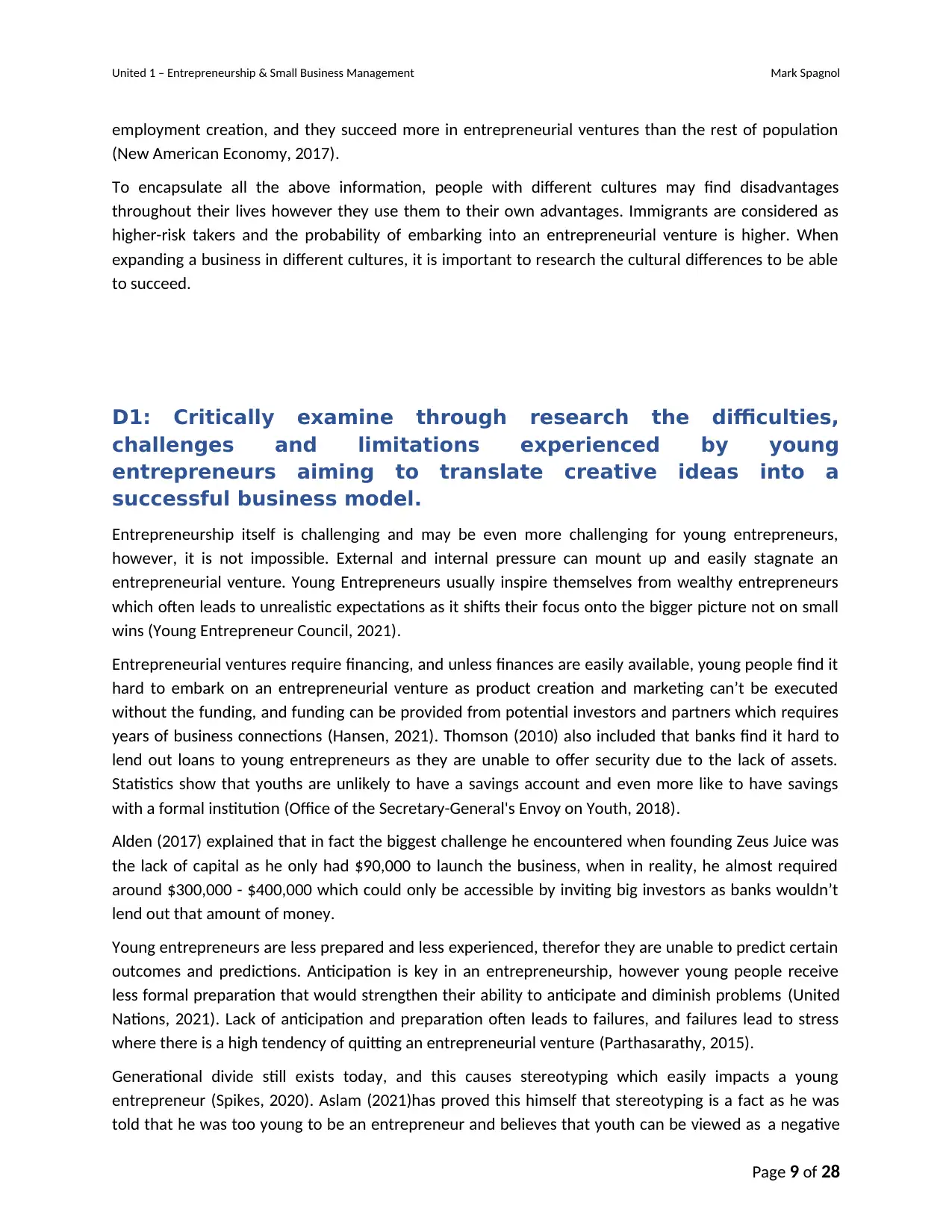
United 1 – Entrepreneurship & Small Business Management Mark Spagnol
employment creation, and they succeed more in entrepreneurial ventures than the rest of population
(New American Economy, 2017).
To encapsulate all the above information, people with different cultures may find disadvantages
throughout their lives however they use them to their own advantages. Immigrants are considered as
higher-risk takers and the probability of embarking into an entrepreneurial venture is higher. When
expanding a business in different cultures, it is important to research the cultural differences to be able
to succeed.
D1: Critically examine through research the difficulties,
challenges and limitations experienced by young
entrepreneurs aiming to translate creative ideas into a
successful business model.
Entrepreneurship itself is challenging and may be even more challenging for young entrepreneurs,
however, it is not impossible. External and internal pressure can mount up and easily stagnate an
entrepreneurial venture. Young Entrepreneurs usually inspire themselves from wealthy entrepreneurs
which often leads to unrealistic expectations as it shifts their focus onto the bigger picture not on small
wins (Young Entrepreneur Council, 2021).
Entrepreneurial ventures require financing, and unless finances are easily available, young people find it
hard to embark on an entrepreneurial venture as product creation and marketing can’t be executed
without the funding, and funding can be provided from potential investors and partners which requires
years of business connections (Hansen, 2021). Thomson (2010) also included that banks find it hard to
lend out loans to young entrepreneurs as they are unable to offer security due to the lack of assets.
Statistics show that youths are unlikely to have a savings account and even more like to have savings
with a formal institution (Office of the Secretary-General's Envoy on Youth, 2018).
Alden (2017) explained that in fact the biggest challenge he encountered when founding Zeus Juice was
the lack of capital as he only had $90,000 to launch the business, when in reality, he almost required
around $300,000 - $400,000 which could only be accessible by inviting big investors as banks wouldn’t
lend out that amount of money.
Young entrepreneurs are less prepared and less experienced, therefor they are unable to predict certain
outcomes and predictions. Anticipation is key in an entrepreneurship, however young people receive
less formal preparation that would strengthen their ability to anticipate and diminish problems (United
Nations, 2021). Lack of anticipation and preparation often leads to failures, and failures lead to stress
where there is a high tendency of quitting an entrepreneurial venture (Parthasarathy, 2015).
Generational divide still exists today, and this causes stereotyping which easily impacts a young
entrepreneur (Spikes, 2020). Aslam (2021)has proved this himself that stereotyping is a fact as he was
told that he was too young to be an entrepreneur and believes that youth can be viewed as a negative
Page 9 of 28
employment creation, and they succeed more in entrepreneurial ventures than the rest of population
(New American Economy, 2017).
To encapsulate all the above information, people with different cultures may find disadvantages
throughout their lives however they use them to their own advantages. Immigrants are considered as
higher-risk takers and the probability of embarking into an entrepreneurial venture is higher. When
expanding a business in different cultures, it is important to research the cultural differences to be able
to succeed.
D1: Critically examine through research the difficulties,
challenges and limitations experienced by young
entrepreneurs aiming to translate creative ideas into a
successful business model.
Entrepreneurship itself is challenging and may be even more challenging for young entrepreneurs,
however, it is not impossible. External and internal pressure can mount up and easily stagnate an
entrepreneurial venture. Young Entrepreneurs usually inspire themselves from wealthy entrepreneurs
which often leads to unrealistic expectations as it shifts their focus onto the bigger picture not on small
wins (Young Entrepreneur Council, 2021).
Entrepreneurial ventures require financing, and unless finances are easily available, young people find it
hard to embark on an entrepreneurial venture as product creation and marketing can’t be executed
without the funding, and funding can be provided from potential investors and partners which requires
years of business connections (Hansen, 2021). Thomson (2010) also included that banks find it hard to
lend out loans to young entrepreneurs as they are unable to offer security due to the lack of assets.
Statistics show that youths are unlikely to have a savings account and even more like to have savings
with a formal institution (Office of the Secretary-General's Envoy on Youth, 2018).
Alden (2017) explained that in fact the biggest challenge he encountered when founding Zeus Juice was
the lack of capital as he only had $90,000 to launch the business, when in reality, he almost required
around $300,000 - $400,000 which could only be accessible by inviting big investors as banks wouldn’t
lend out that amount of money.
Young entrepreneurs are less prepared and less experienced, therefor they are unable to predict certain
outcomes and predictions. Anticipation is key in an entrepreneurship, however young people receive
less formal preparation that would strengthen their ability to anticipate and diminish problems (United
Nations, 2021). Lack of anticipation and preparation often leads to failures, and failures lead to stress
where there is a high tendency of quitting an entrepreneurial venture (Parthasarathy, 2015).
Generational divide still exists today, and this causes stereotyping which easily impacts a young
entrepreneur (Spikes, 2020). Aslam (2021)has proved this himself that stereotyping is a fact as he was
told that he was too young to be an entrepreneur and believes that youth can be viewed as a negative
Page 9 of 28
Paraphrase This Document
Need a fresh take? Get an instant paraphrase of this document with our AI Paraphraser
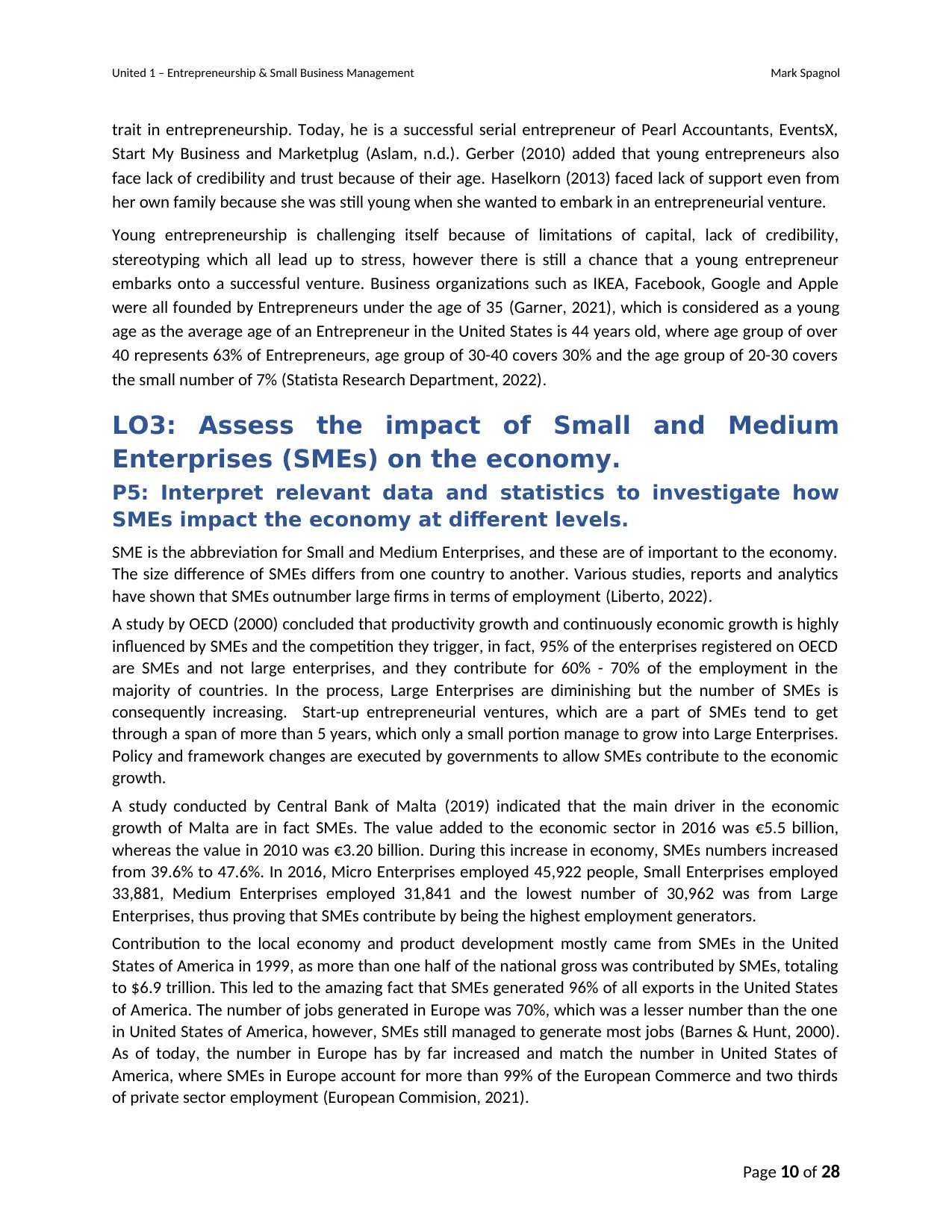
United 1 – Entrepreneurship & Small Business Management Mark Spagnol
trait in entrepreneurship. Today, he is a successful serial entrepreneur of Pearl Accountants, EventsX,
Start My Business and Marketplug (Aslam, n.d.). Gerber (2010) added that young entrepreneurs also
face lack of credibility and trust because of their age. Haselkorn (2013) faced lack of support even from
her own family because she was still young when she wanted to embark in an entrepreneurial venture.
Young entrepreneurship is challenging itself because of limitations of capital, lack of credibility,
stereotyping which all lead up to stress, however there is still a chance that a young entrepreneur
embarks onto a successful venture. Business organizations such as IKEA, Facebook, Google and Apple
were all founded by Entrepreneurs under the age of 35 (Garner, 2021), which is considered as a young
age as the average age of an Entrepreneur in the United States is 44 years old, where age group of over
40 represents 63% of Entrepreneurs, age group of 30-40 covers 30% and the age group of 20-30 covers
the small number of 7% (Statista Research Department, 2022).
LO3: Assess the impact of Small and Medium
Enterprises (SMEs) on the economy.
P5: Interpret relevant data and statistics to investigate how
SMEs impact the economy at different levels.
SME is the abbreviation for Small and Medium Enterprises, and these are of important to the economy.
The size difference of SMEs differs from one country to another. Various studies, reports and analytics
have shown that SMEs outnumber large firms in terms of employment (Liberto, 2022).
A study by OECD (2000) concluded that productivity growth and continuously economic growth is highly
influenced by SMEs and the competition they trigger, in fact, 95% of the enterprises registered on OECD
are SMEs and not large enterprises, and they contribute for 60% - 70% of the employment in the
majority of countries. In the process, Large Enterprises are diminishing but the number of SMEs is
consequently increasing. Start-up entrepreneurial ventures, which are a part of SMEs tend to get
through a span of more than 5 years, which only a small portion manage to grow into Large Enterprises.
Policy and framework changes are executed by governments to allow SMEs contribute to the economic
growth.
A study conducted by Central Bank of Malta (2019) indicated that the main driver in the economic
growth of Malta are in fact SMEs. The value added to the economic sector in 2016 was €5.5 billion,
whereas the value in 2010 was €3.20 billion. During this increase in economy, SMEs numbers increased
from 39.6% to 47.6%. In 2016, Micro Enterprises employed 45,922 people, Small Enterprises employed
33,881, Medium Enterprises employed 31,841 and the lowest number of 30,962 was from Large
Enterprises, thus proving that SMEs contribute by being the highest employment generators.
Contribution to the local economy and product development mostly came from SMEs in the United
States of America in 1999, as more than one half of the national gross was contributed by SMEs, totaling
to $6.9 trillion. This led to the amazing fact that SMEs generated 96% of all exports in the United States
of America. The number of jobs generated in Europe was 70%, which was a lesser number than the one
in United States of America, however, SMEs still managed to generate most jobs (Barnes & Hunt, 2000).
As of today, the number in Europe has by far increased and match the number in United States of
America, where SMEs in Europe account for more than 99% of the European Commerce and two thirds
of private sector employment (European Commision, 2021).
Page 10 of 28
trait in entrepreneurship. Today, he is a successful serial entrepreneur of Pearl Accountants, EventsX,
Start My Business and Marketplug (Aslam, n.d.). Gerber (2010) added that young entrepreneurs also
face lack of credibility and trust because of their age. Haselkorn (2013) faced lack of support even from
her own family because she was still young when she wanted to embark in an entrepreneurial venture.
Young entrepreneurship is challenging itself because of limitations of capital, lack of credibility,
stereotyping which all lead up to stress, however there is still a chance that a young entrepreneur
embarks onto a successful venture. Business organizations such as IKEA, Facebook, Google and Apple
were all founded by Entrepreneurs under the age of 35 (Garner, 2021), which is considered as a young
age as the average age of an Entrepreneur in the United States is 44 years old, where age group of over
40 represents 63% of Entrepreneurs, age group of 30-40 covers 30% and the age group of 20-30 covers
the small number of 7% (Statista Research Department, 2022).
LO3: Assess the impact of Small and Medium
Enterprises (SMEs) on the economy.
P5: Interpret relevant data and statistics to investigate how
SMEs impact the economy at different levels.
SME is the abbreviation for Small and Medium Enterprises, and these are of important to the economy.
The size difference of SMEs differs from one country to another. Various studies, reports and analytics
have shown that SMEs outnumber large firms in terms of employment (Liberto, 2022).
A study by OECD (2000) concluded that productivity growth and continuously economic growth is highly
influenced by SMEs and the competition they trigger, in fact, 95% of the enterprises registered on OECD
are SMEs and not large enterprises, and they contribute for 60% - 70% of the employment in the
majority of countries. In the process, Large Enterprises are diminishing but the number of SMEs is
consequently increasing. Start-up entrepreneurial ventures, which are a part of SMEs tend to get
through a span of more than 5 years, which only a small portion manage to grow into Large Enterprises.
Policy and framework changes are executed by governments to allow SMEs contribute to the economic
growth.
A study conducted by Central Bank of Malta (2019) indicated that the main driver in the economic
growth of Malta are in fact SMEs. The value added to the economic sector in 2016 was €5.5 billion,
whereas the value in 2010 was €3.20 billion. During this increase in economy, SMEs numbers increased
from 39.6% to 47.6%. In 2016, Micro Enterprises employed 45,922 people, Small Enterprises employed
33,881, Medium Enterprises employed 31,841 and the lowest number of 30,962 was from Large
Enterprises, thus proving that SMEs contribute by being the highest employment generators.
Contribution to the local economy and product development mostly came from SMEs in the United
States of America in 1999, as more than one half of the national gross was contributed by SMEs, totaling
to $6.9 trillion. This led to the amazing fact that SMEs generated 96% of all exports in the United States
of America. The number of jobs generated in Europe was 70%, which was a lesser number than the one
in United States of America, however, SMEs still managed to generate most jobs (Barnes & Hunt, 2000).
As of today, the number in Europe has by far increased and match the number in United States of
America, where SMEs in Europe account for more than 99% of the European Commerce and two thirds
of private sector employment (European Commision, 2021).
Page 10 of 28
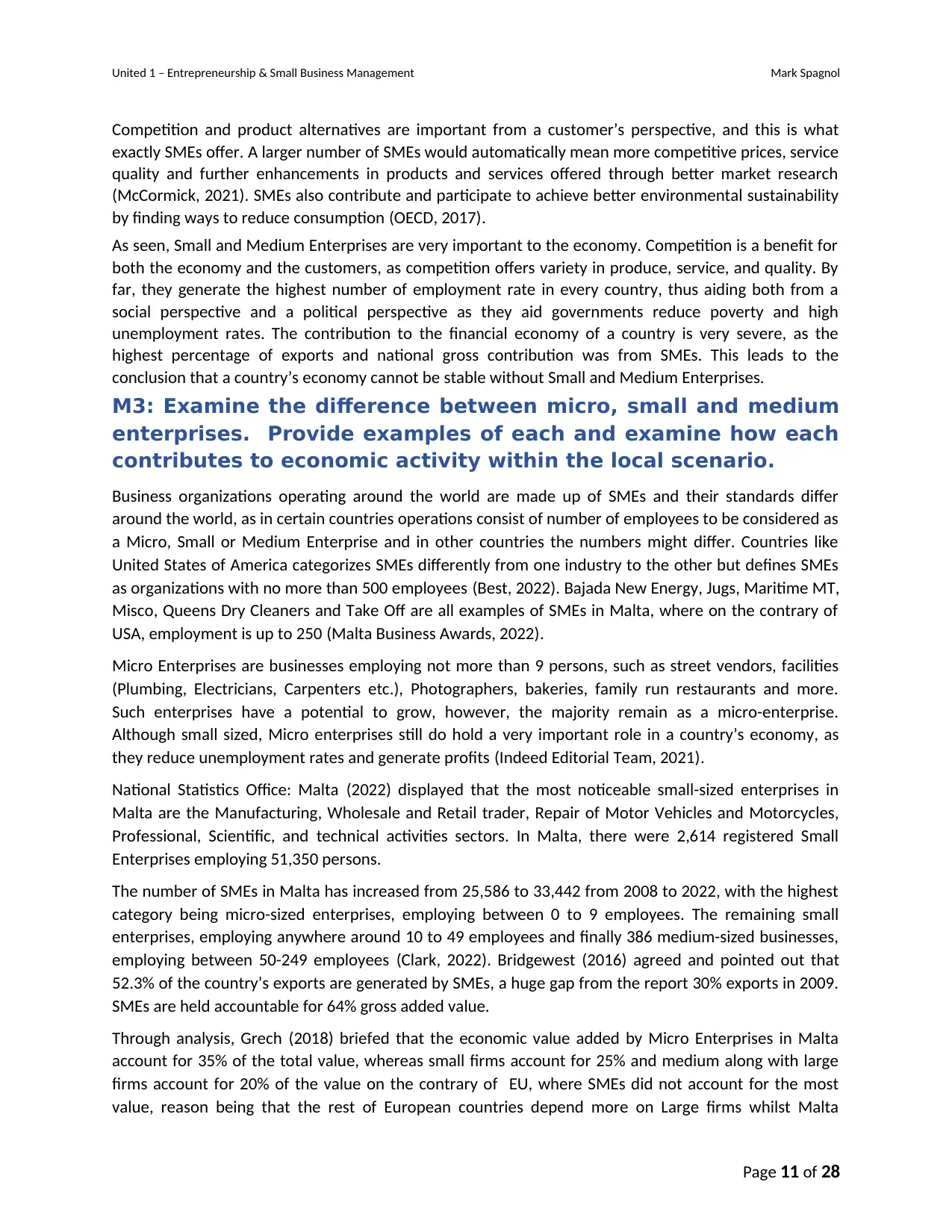
United 1 – Entrepreneurship & Small Business Management Mark Spagnol
Competition and product alternatives are important from a customer’s perspective, and this is what
exactly SMEs offer. A larger number of SMEs would automatically mean more competitive prices, service
quality and further enhancements in products and services offered through better market research
(McCormick, 2021). SMEs also contribute and participate to achieve better environmental sustainability
by finding ways to reduce consumption (OECD, 2017).
As seen, Small and Medium Enterprises are very important to the economy. Competition is a benefit for
both the economy and the customers, as competition offers variety in produce, service, and quality. By
far, they generate the highest number of employment rate in every country, thus aiding both from a
social perspective and a political perspective as they aid governments reduce poverty and high
unemployment rates. The contribution to the financial economy of a country is very severe, as the
highest percentage of exports and national gross contribution was from SMEs. This leads to the
conclusion that a country’s economy cannot be stable without Small and Medium Enterprises.
M3: Examine the difference between micro, small and medium
enterprises. Provide examples of each and examine how each
contributes to economic activity within the local scenario.
Business organizations operating around the world are made up of SMEs and their standards differ
around the world, as in certain countries operations consist of number of employees to be considered as
a Micro, Small or Medium Enterprise and in other countries the numbers might differ. Countries like
United States of America categorizes SMEs differently from one industry to the other but defines SMEs
as organizations with no more than 500 employees (Best, 2022). Bajada New Energy, Jugs, Maritime MT,
Misco, Queens Dry Cleaners and Take Off are all examples of SMEs in Malta, where on the contrary of
USA, employment is up to 250 (Malta Business Awards, 2022).
Micro Enterprises are businesses employing not more than 9 persons, such as street vendors, facilities
(Plumbing, Electricians, Carpenters etc.), Photographers, bakeries, family run restaurants and more.
Such enterprises have a potential to grow, however, the majority remain as a micro-enterprise.
Although small sized, Micro enterprises still do hold a very important role in a country’s economy, as
they reduce unemployment rates and generate profits (Indeed Editorial Team, 2021).
National Statistics Office: Malta (2022) displayed that the most noticeable small-sized enterprises in
Malta are the Manufacturing, Wholesale and Retail trader, Repair of Motor Vehicles and Motorcycles,
Professional, Scientific, and technical activities sectors. In Malta, there were 2,614 registered Small
Enterprises employing 51,350 persons.
The number of SMEs in Malta has increased from 25,586 to 33,442 from 2008 to 2022, with the highest
category being micro-sized enterprises, employing between 0 to 9 employees. The remaining small
enterprises, employing anywhere around 10 to 49 employees and finally 386 medium-sized businesses,
employing between 50-249 employees (Clark, 2022). Bridgewest (2016) agreed and pointed out that
52.3% of the country’s exports are generated by SMEs, a huge gap from the report 30% exports in 2009.
SMEs are held accountable for 64% gross added value.
Through analysis, Grech (2018) briefed that the economic value added by Micro Enterprises in Malta
account for 35% of the total value, whereas small firms account for 25% and medium along with large
firms account for 20% of the value on the contrary of EU, where SMEs did not account for the most
value, reason being that the rest of European countries depend more on Large firms whilst Malta
Page 11 of 28
Competition and product alternatives are important from a customer’s perspective, and this is what
exactly SMEs offer. A larger number of SMEs would automatically mean more competitive prices, service
quality and further enhancements in products and services offered through better market research
(McCormick, 2021). SMEs also contribute and participate to achieve better environmental sustainability
by finding ways to reduce consumption (OECD, 2017).
As seen, Small and Medium Enterprises are very important to the economy. Competition is a benefit for
both the economy and the customers, as competition offers variety in produce, service, and quality. By
far, they generate the highest number of employment rate in every country, thus aiding both from a
social perspective and a political perspective as they aid governments reduce poverty and high
unemployment rates. The contribution to the financial economy of a country is very severe, as the
highest percentage of exports and national gross contribution was from SMEs. This leads to the
conclusion that a country’s economy cannot be stable without Small and Medium Enterprises.
M3: Examine the difference between micro, small and medium
enterprises. Provide examples of each and examine how each
contributes to economic activity within the local scenario.
Business organizations operating around the world are made up of SMEs and their standards differ
around the world, as in certain countries operations consist of number of employees to be considered as
a Micro, Small or Medium Enterprise and in other countries the numbers might differ. Countries like
United States of America categorizes SMEs differently from one industry to the other but defines SMEs
as organizations with no more than 500 employees (Best, 2022). Bajada New Energy, Jugs, Maritime MT,
Misco, Queens Dry Cleaners and Take Off are all examples of SMEs in Malta, where on the contrary of
USA, employment is up to 250 (Malta Business Awards, 2022).
Micro Enterprises are businesses employing not more than 9 persons, such as street vendors, facilities
(Plumbing, Electricians, Carpenters etc.), Photographers, bakeries, family run restaurants and more.
Such enterprises have a potential to grow, however, the majority remain as a micro-enterprise.
Although small sized, Micro enterprises still do hold a very important role in a country’s economy, as
they reduce unemployment rates and generate profits (Indeed Editorial Team, 2021).
National Statistics Office: Malta (2022) displayed that the most noticeable small-sized enterprises in
Malta are the Manufacturing, Wholesale and Retail trader, Repair of Motor Vehicles and Motorcycles,
Professional, Scientific, and technical activities sectors. In Malta, there were 2,614 registered Small
Enterprises employing 51,350 persons.
The number of SMEs in Malta has increased from 25,586 to 33,442 from 2008 to 2022, with the highest
category being micro-sized enterprises, employing between 0 to 9 employees. The remaining small
enterprises, employing anywhere around 10 to 49 employees and finally 386 medium-sized businesses,
employing between 50-249 employees (Clark, 2022). Bridgewest (2016) agreed and pointed out that
52.3% of the country’s exports are generated by SMEs, a huge gap from the report 30% exports in 2009.
SMEs are held accountable for 64% gross added value.
Through analysis, Grech (2018) briefed that the economic value added by Micro Enterprises in Malta
account for 35% of the total value, whereas small firms account for 25% and medium along with large
firms account for 20% of the value on the contrary of EU, where SMEs did not account for the most
value, reason being that the rest of European countries depend more on Large firms whilst Malta
Page 11 of 28
⊘ This is a preview!⊘
Do you want full access?
Subscribe today to unlock all pages.

Trusted by 1+ million students worldwide
1 out of 28
Related Documents
Your All-in-One AI-Powered Toolkit for Academic Success.
+13062052269
info@desklib.com
Available 24*7 on WhatsApp / Email
![[object Object]](/_next/static/media/star-bottom.7253800d.svg)
Unlock your academic potential
Copyright © 2020–2025 A2Z Services. All Rights Reserved. Developed and managed by ZUCOL.



